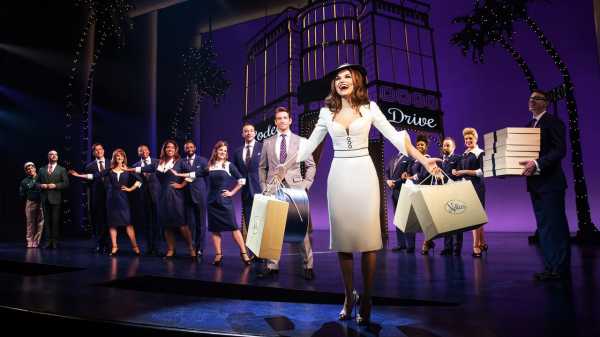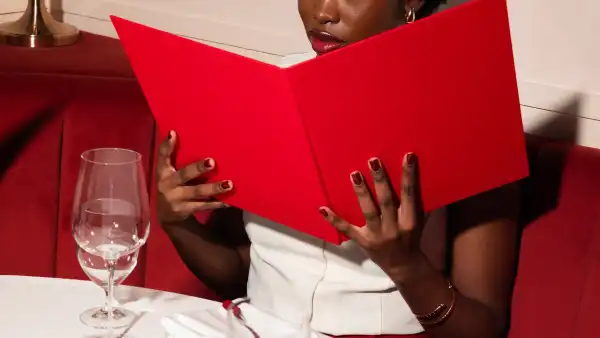
Late in “Pretty Woman”—both the 1990 megahit film and the newly opened Broadway musical—Vivian, a call girl who has been lifted from the squalor of Hollywood Boulevard to the penthouse of the Beverly Wilshire, asks her friend Kit to name one single, solitary example of a girl like them living happily ever after with a guy like Edward, the rich businessman who has hired Vivian for the week. Kit thinks for a moment, then announces, “Cinda-fuckin’-rella!”
“Pretty Woman” wasn’t meant to be a Cinderella story. Originally, J. F. Lawton’s screenplay was a gritty drama about the hard-knock lives of Los Angeles prostitutes, titled “3000,” after the price that Edward plunks down for Vivian’s company. It was Jeffrey Katzenberg, the story goes, who refashioned it as an aspirational fairy tale suitable for Touchstone Pictures, a division of Disney. (What remained of the cautionary tale zips by in the film’s first few minutes, as the body of a junkie streetwalker is fished out of a dumpster.) Katzenberg’s gambit paid off: “Pretty Woman” became the third-highest-grossing film of the year, with a worldwide haul nearing half a billion dollars, and made an international star of Julia Roberts.
From the start, “Pretty Woman” inspired critical hand-wringing. Was the movie, as two recent reassessments have had it, a “crass, degrading power fantasy,” or a stealth “feminist classic”? On the one hand, the film sugarcoats sex work, celebrates conspicuous consumption, and burnishes a retrograde princess narrative. On the other, Vivian has a clear sense of what she wants and what her boundaries are, and, as much as Edward rescues her, she—say it with me—rescues him right back.
One need look no further than Meghan Markle for proof that Cinderella stories still appeal, because they fulfill two fantasies at once: those of true love and class mobility. But “Pretty Woman” pulls on another strand as well: the Pygmalion myth. In Ovid’s version, a sculptor carves an ivory statue of a woman so beautiful that he falls in love with his own creation (sometimes called Galatea), and Aphrodite grants his wish by making her real. The fantasy has been retold a thousand times, most famously by George Bernard Shaw, whose version featured a phonetics professor who remakes a Cockney flower girl into an Edwardian lady. Last season, I counted three Pygmalion tales on New York stages, each tweaked for the modern era. The downtown troupe Bedlam did Shaw’s “Pygmalion,” with an Anglo-Indian Eliza Doolittle. “Children of a Lesser God,” in which a teacher at a school for the deaf trains his inamorata to speak, made a brief return to Broadway, with a mixed-race cast. And Lincoln Center Theatre revived “My Fair Lady,” the 1956 musicalization of Shaw’s play, with an Eliza who walks out on her maker in the final scene.
“Pretty Woman” is notable among Pygmalion stories in that Edward doesn’t teach Vivian how to be a lady; he hands her a credit card and outsources the rest to Barney, the hotel manager. In the film, Barney (Hector Elizondo) shows Vivian which forks to use at a fancy table setting. On Broadway, the director and choreographer Jerry Mitchell shows off his chops by having Barney give Vivian a lesson in ballroom dancing. More than Edward, Barney seems to recognize Vivian’s natural gifts—her inner “class”—and it’s easy to imagine an alternative ending in which she ditches Edward for her truer admirer. But then she wouldn’t have skipped up a few socioeconomic rungs on her way to love. This is Edward’s world, where everything can be bought, including a store manager instructed to “suck up” to Vivian for an “obscene” sum.
In her book “Feminist Film Theory and Pretty Woman,” the scholar Mari Ruti points out the multiple ways in which Vivian and Edward’s transformations uphold gender norms, even as they signal parity. Edward is a corporate raider who, Vivian observes, doesn’t “make anything”—he buys companies and sells them for parts. Under her influence, he reverses a deal to demolish a shipbuilding firm so that he can “build” something, presumably Navy destroyers. (Previously, he had tied up the company’s government contract in the Senate Appropriations Committee. Today we’d call him “the swamp.”) If Edward is an industrialist who doesn’t know how to make anything (including his own Galatea), Vivian is a feminine consumer who doesn’t know how to spend money—until she’s refashioned into the toast of Rodeo Drive. Ultimately, in matters of sex and money, “Pretty Woman” wants to have its cake and charge it on the Amex, too. Vivian is the inverse of Glenn Close’s villain in “Fatal Attraction,” made three years earlier: while Alex Forrest is a financially independent homewrecker who will not be ignored, Vivian is a pliable, buyable Galatea whose liberation ends in romantic union with her john. Edward, meanwhile, is a variation on Gordon Gekko, Michael Douglas’s finance shark in “Wall Street”—except he finally decides that greed, while good, isn’t as good as love. Still, why not have both?
Reports that the creators of the Broadway “Pretty Woman” were “reshaping” the story for the #MeToo era have been greatly exaggerated. Recent film-to-stage adaptations, notably “Mean Girls” and “Groundhog Day,” have taken the opportunity to wrestle with their own material, or at least update it with smartphones. But Lawton and the film’s director, the late Garry Marshall, who co-wrote the book, have clearly taken a “don’t mess with success” approach, virtually cutting and pasting every outfit reveal and iconic line. “Big mistake. Big. Huge,” Vivian still tells those stuck-up Rodeo Drive salesgirls, guaranteeing a burst of applause at the Nederlander Theatre. In the one concession to 2018 self-empowerment, Vivian now fends off her would-be rapist—Edward’s sleazy lawyer—herself, instead of letting her white knight save her. Still, she wants that white knight to climb up her fire escape.
Perhaps it’s unsurprising that a love story hung up on money should wring some extra dollars on Broadway. So what’s new? Generic soft-rock anthems, by Bryan Adams and Jim Vallance, stuffed with trite lyrics about how everyone has a dream. (The song titles, such as “Anywhere but Here” and “I Can’t Go Back,” scarcely need elaboration.) Stepping into Julia Roberts’s leather boots, Samantha Barks, from the “Les Misérables” film, is agreeable as Vivian, and Andy Karl—who proved how well he could play charming assholes in “Groundhog Day”—is an appealingly handsome Edward. The bright spots, though, come from the supporting cast, including Eric Anderson, double cast as Barney and a street vender selling maps to the stars, and Orfeh, who, as Kit, actually seems to be having fun. But it’s clear that the all-male creative team hasn’t interrogated the story, beyond selling T-shirts that pair the title with phrases like “Funny Woman” and “Strong Woman.”
In the movie’s most iconic moment, Richard Gere snaps a jewelry box at Julia Roberts’s hand, and she cracks that megawatt smile as she yelps and guffaws. According to Garry Marshall, the moment was entirely improvised, a prank intended for the gag reel. The musical, of course, re-creates the snap, the flinch, the laugh, but it feels as spontaneous as an algebra test. Still, it’s the image that defines “Pretty Woman”: a rented woman, reaching for a rented necklace, and a man who yanks it away like a little girl’s lollipop.
Sourse: newyorker.com






